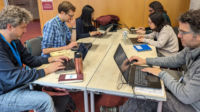At the end of May, members of the EERIE project participated at the Cycle 3 Hackathon organized by the nextGEMS project at the Universidad Complutense in Madrid. NextGEMS is a European-funded project to build prototypes for new storm-resolving earth system models (this is, with extremely fine horizontal grids), which will allow representing the climate system for the next 30 years much more realistically.

The EERIE project participants attending the nextGEMS hackathon in Madrid
For about a week, participants at the Hackathon had the opportunity to analyze the data of the new Cycle 3 simulations from the three climate models contributing to nextGEMS, while interacting with many top scientists from all over the world. The participants, divided into different thematic groups (Atmosphere, Ocean, Land, and Society), engaged into discussions about the advances in a diversity of processes (such as precipitation and cloud distribution, linkages between wind stress and the mixed layer depth over the Southern Ocean, fronts along tropical instability waves, and tropical cyclones) on wide range of scales (from very local, for example just over Paris, to global scales), taking advantage of the extremely high temporal and spatial scale of the simulations. The data, nicely prepared by the modeling centers to facilitate their analysis, encouraged participants to use new and more effective tools, grids, and organization systems. Participants in the Ocean groups, for example, applied an algorithm for ocean eddy tracking that provides the main characteristics of the eddies, including their size, location, and spin direction. All the participants also got the opportunity to interact with the new grid of the ICON model, HEALPix, which is designed to facilitate data analysis. For some others, this Hackathon was their first opportunity to use different analysis tools for the first time (python, for example). The meeting thus served as the perfect platform for the exchange of ideas and fun science. By the end of the meeting, each of the thematic groups presented their findings and discussed the results.
The participants also enjoyed three keynotes lectures, by Prof. Katja Fennel (Dalhousie University), Prof. Francisco Doblas Reyes (Barcelona Supercomputing Center), and Prof. Yukari Takayabu (University of Tokyo), who covered recent efforts in biogeochemistry modeling and observation, user-oriented high-resolution modeling in DestinE, and the observations of heavy precipitation events respectively.
In many aspects, the nextGEMS Hackathon proved to be a very successful story for EERIE. The meeting represented an ideal setting for its members to engage with projects with similar interests in high-resolution modeling, helping bridge future collaborations and synergies. So it was made clear on the last meeting day, when it was highlighted that the experiments planned within EERIE might benefit nextGEMS members to study climate change with a temporal extent longer than it is currently planned in the project. Meeting in Madrid also let EERIE members start to know each other and build the much-needed network that will lead to the project success. Similarly, it also allowed us to gather ideas and plans for the organization of our own hackathon in November 2023.




